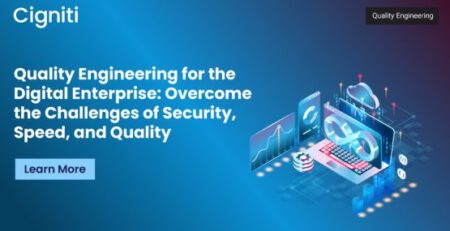Top 5 skills SDETs need to develop right now!
The skills required for Software Development and Quality Assurance need to evolve constantly. Moreover, with the challenges thrown by Digital Transformation, there is a need to continuously innovate ways and means to achieve excellence in quality. Software Development Engineers in Test (SDETs) are expected to deliver effectively in development as well as testing. Hence, it is important that they keep upgrading their skill sets with new tools and methodologies, and in all possible ways enhance the end result.
An SDET is expected to showcase expertise on the grounds of testability, agility, robustness, resilience, and performance. They even contribute towards designing the production software by reviewing it. Comprehending their significance in the development scenario, it is imperative that their knowledge and skill sets keep upgrading. You would agree that the current application development scenario is transforming at a pace that is inconceivable. So, let’s look at the key skills that SDETs need to embrace in this revolutionizing space.
1. Get clarity on the Scope of Work
Why is it absolutely necessary to drill down and get all the possible details regarding the application or project at hand? It ultimately helps to build the right strategy for planning the testing and development activities. Hence, it is important that an SDET asks the right questions related to the application – its usage, the end users, peak usage periods, configurations it will operate on, devices it will be used on, and much more.
For instance, if it’s an eCommerce site that experiences spikes in user traffic, the focus would be on Stress Testing/Performance Testing/Load Testing. If it’s a stock trading application, the SDET will have to emphasize on Security Testing/Vulnerability Testing. Likewise, it is business critical to source every detail to deliver the expected outcome. SDET holds an important role to liaison with different parties to collate the required information, and deliver quality.
2. Look beyond Testing and Development
Software Testing and Quality Assurance are absolutely integral to the software development cycle. However, in the current digital landscape, quality assurance is a strategic decision. It goes beyond just conducting the required tests and validation. Essentially, an SDET must pay minute attention and keep open ears for identifying risks and defects within an application. SDETs need to develop the ability to look at the application objectively from a user’s perspective and then work on it.
Moreover, it is important that the perspective of the business stakeholders should be considered. This can provide clarity and boost efficiency for better productivity. When it comes to business stakeholders, SDETs need to specifically understand that they don’t need technical download or a list of test codes. Business folks need the larger picture, which has to be provided during key meetings and stand-ups. In this way, both the parties speak the same language and deliver the expected outcome.
3. Build Business Agility
Methodologies such as Agile and DevOps have provided the scalability to testing and development teams for accommodating as many business requirements as possible at various stages. Going forward, testing teams will have to get more and more flexible, as consumer preferences will keep shifting and applications will get more complex and layered. Hence, there has to be added focus on collaborative approach, more stand-up meetings, video conferencing, open communication channels, and anything that supports agility.
SDETs need to build a culture that makes testing teams more approachable and responsive to changes. This will encourage constant innovation, resulting in better work satisfaction.
4. Emphasize on Automation with objectives
How can you expect innovation and creativity, if a tester and a developer gets caught up in mundane and arduous tasks? Test Automation has helped teams to skip the routine tasks and take a step further to look at the bigger picture of the application. There are multiple tools that are available in the market, both Licensed and Open source to conduct and monitor test automation.
However, an SDET must understand the end objective that has to be achieved with automation before planning the automation strategy. Automation is definitely indispensable, but executing it without the ultimate objectives into perspective, can be disastrous. Ultimately, there are investments involved and teams are accountable for the results.
5. Manage time, expectations, and judgements
The entire development cycle revolves around People, Processes, and Tools. Today, businesses need to adopt new and emerging technologies to deliver value for the consumers. This puts a lot at stake, where SDETs are expected to manage the growing expectations, deliver within stringent timelines, and depend on their experience over the years.
There are a lot of factors that need to be considering while testing and validating an application’s health. Factors such as Functionality, Security, Accessibility, and ultimately User Experience (UX) play a major role in ensuring stability of the application when it goes in the hands of the users. In order to bring all this together, SDETs must ensure that their skill sets get upgraded regularly, and they go through regular training sessions to stay relevant in the development space. This will help them to segment their judgements from intuitions.
Accordingly to a report by Forrester titled ‘Digital Business 2018: Benchmark Your Digital Journey’, ‘Your firm’s business success and future growth will increasingly depend upon its ability to tap into key digital business capabilities. It takes courage and a strong CEO mandate to succeed.’
Many similar Analyst reports establish that ‘Digital Disruption’ is the need of the hour and it’s not optional. Hence, CEOs will have to go through the churn and developers/testers will have support and twist their ways to make this possible. SDETs are expected to keep an ‘open perspective’ towards change while this happens.
Cigniti’s Digital Assurance solutions address the multifaceted needs of digital testing. We strive to do this by conducting comprehensive testing across your digital value chain and the entire digital ecosystem.
Connect with us to leverage the required skill sets and infrastructure, and help your organization achieve Digital Excellence.





Leave a Reply